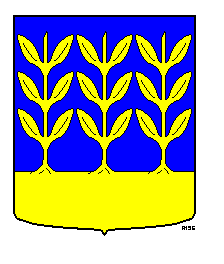Perfect for framing: that’s how beautiful the conservation village of Twisk is. A picture postcard full of lovingly restored traditional farmhouses, churches and historical houses. The village has no less than fifty listed buildings. Magnificent! Obviously, many day visitors cycle here from the harbour town of Medemblik. From the high spine of the West Frisian Circular Dike you can see the church tower of Twisk ahead in the distance.
The surrounding area is exceptionally beautiful to say the least. Enjoy your visit there by taking a ride on the steam train from Hoorn to Medemblik, which stops at the historical station of Twisk. Did you known that the largest concentration of traditional ‘stolp’ farmhouses in North Holland can be found here? In bygone days, these pyramids of the polder had their hay barns in the centre of the house. The box-beds were built beside them, as it was nice and warm.

Twisk’s symbol:
“Lapis Lazuli, loaded with 3 dry stubble, standing on a terrace, all of gold.”
Twisk is characterized as a real ribbon village of approx. 5 km in length. Only since the 20th century, a few blocks with new construction have emerged.
In 1840, the municipality of Twisk has 113 houses with 655 inhabitants. Today, the village has around 450 houses with around 1,000 inhabitants.
The history of Twisk can be read on the website of Twisca.
National monuments in Twisk
Twisk has 51 national monuments. In addition to the Reformed church and parsonage and the Baptist Vermaning, these are mainly monumental houses. The village has one of the highest concentrations of farmhouses in the Netherlands: of the approximately 450 residential houses, no fewer than 100 are of the type farmhouse, in all variants, from simple to richly detailed. Partly because of this, the development on the Dorpsweg in 1970, and partly in 1974, was designated as a protected townscape.


Theater Church Hemels
The church has been around since the 14th century and is located in the heart of the beautiful village of Twisk, where there are about 50 other monumental buildings. The exact date of construction of the church is unknown. The oldest note on this comes from archives dating from 1395 from the Dom of Utrecht, to which the building belonged at the time. Nothing is known about the period before the reformation in 1517. What we do know is that in 1572 Sixtus Rippirus was the first minister to be named. The register of the local church order dates from 1658.
We now welcome various art forms in the church hall. The spacious, high church hall has beautiful acoustics and a beautiful stage. We program music and theater ourselves, but the room can also be rented for your own performances. This creates a beautiful mix of music and theater, known and unknown, local and national, for young and old.
Look for the current program on https://www.theaterkerkhemels.nl.


Tea gardens in Twisk
Tea garden ‘bij de Haan’
The Tea Garden of Family de Haan is within walking distance of the Melchiorhoeve. Ruud and Saskia de Haan started the tea garden on Dorpsweg K61 in 2019. When you leave the Melchiorhoeve you turn right. You will find the tea garden after 500 meters on your right.
Take a look at the ‘tea garden site’ for the possibilities.

Tea Garden Pronkjewail
The Pronkjewail tea garden is approximately 2.3 km from the Melchiorhoeve. This tea garden is open from May to October on Friday, Saturday and Sunday.
The tea garden is located on the Zuiderweg 7. You turn right at the Melchiorhoeve. You drive until you reach the junction (after about 2 km). Turn right at the junction. You will find the tea garden after approximately 300 meters on your left.
